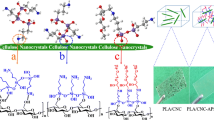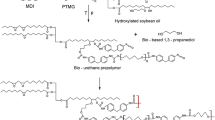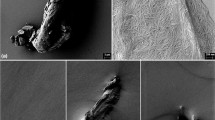Abstract
Despite the wide availability of cellulose, this polyhydroxylated polysaccharide has practically not been used in the synthesis of polyurethanes (PUs), a family of polymers with great versatility. Microcrystalline cellulose (MCC) was used as a polyol to synthesize PUs, mostly at room temperature, with no solvent or catalyst, and simultaneous film formation. Castor oil (CO) was used as an additional polyol and MCC dispersant in the reaction medium. 0–60% of MCC was used regarding the concentration of hydroxyl groups in CO. FTIR spectroscopy indicated that all of the isocyanate groups reacted. The films were extensively characterized; in short, they exhibit transparency, high crystallinity (~ 75%; scanning electron microscopy and polarized light microscopy suggest the formation of spherulite), intermediate hydrophobicity (contact angle > 85°). Considering the control film (100% CO as polyol) and the film prepared using 60% MCC, Tg ranged from sub-ambient (9 °C) to 78 °C, tensile strength from 0.2 to 14 MPa, Young's modulus from 2 to 474 MPa, and elongation from 21 to 13% (the film prepared using 45% MCC showed 102%). The results from ultraviolet–visible spectroscopy, thermogravimetry, and swelling tests are also shown. The properties of the films formed during the reaction performed at 100 °C (using 60% MCC) were discussed. Biocompatibility tests showed cell viability above 90% after 168 h, indicating non-cytotoxicity for the tested films. The wide range of results demonstrated the feasibility of using MCC as a polyol, indicating applications for the films generated as coatings, packaging, dressings, among others. As far as is known, the approach of this study is unprecedented.
Graphical abstract





should be at “Scanning Electron Microscopy.”



should be at “Thermogravimetric analysis”





Similar content being viewed by others
References
Ahvenainen P, Kontro I, Svedström K (2016) Comparison of sample crystallinity determination methods by X-ray diffraction for challenging cellulose I materials. Cellulose 23:1073–1086. https://doi.org/10.1007/s10570-016-0881-6
Belachew T, Gebino G, Haile A (2021) Extraction and characterization of indigenous Ethiopian castor oil bast fibre. Cellulose 28:2075–2086. https://doi.org/10.1007/s10570-020-03667-9
Cao S, Li S, Li M et al (2017) A thermal self-healing polyurethane thermoset based on phenolic urethane. Polym J 49:775–781. https://doi.org/10.1038/pj.2017.48
Cassales A, Ramos LA, Frollini E (2020) Synthesis of bio-based polyurethanes from Kraft lignin and castor oil with simultaneous film formation. Int J Biol Macromol 145:28–41. https://doi.org/10.1016/j.ijbiomac.2019.12.173
Chen Y-C, Tai W (2018) Castor oil-based polyurethane resin for low-density composites with bamboo charcoal. Polymers (basel) 10:1–12. https://doi.org/10.3390/polym10101100
Crist B, Schultz JM (2016) Polymer spherulites: a critical review. Prog Polym Sci 56:1–63. https://doi.org/10.1016/j.progpolymsci.2015.11.006
da Silva JEE, Alarcon RT, Gaglieri C et al (2018) New thermal study of polymerization and degradation kinetics of methylene diphenyl diisocyanate. J Therm Anal Calorim 133:1455–1462. https://doi.org/10.1007/s10973-018-7211-1
de Oliveira F, Ramires EC, Frollini E, Belgacem MN (2015) Lignopolyurethanic materials based on oxypropylated sodium lignosulfonate and castor oil blends. Ind Crops Prod 72:77–86. https://doi.org/10.1016/j.indcrop.2015.01.023
de Oliveira F, Gonçalves LP, Belgacem MN, Frollini E (2020) Polyurethanes from plant- and fossil-sourced polyols: properties of neat polymers and their sisal composites. Ind Crops Prod 155:112821. https://doi.org/10.1016/j.indcrop.2020.112821
Dioguardi M, Perrone D, Troiano G et al (2015) Cytotoxicity evaluation of five different dual-cured resin cements used for fiber posts cementation. Int J Clin Exp Med 8:9327–9333
Duan C, Long Y, Li J et al (2015) Changes of cellulose accessibility to cellulase due to fiber hornification and its impact on enzymatic viscosity control of dissolving pulp. Cellulose 22:2729–2736. https://doi.org/10.1007/s10570-015-0636-9
Dwivedi C, Pandey I, Pandey H et al (2017) Electrospun nanofibrous scaffold as a potential carrier of antimicrobial therapeutics for diabetic wound healing and tissue regeneration. In: Grumezescu AM (ed) Nano- and microscale drug delivery systems: design and fabrication. Elsevier Inc., Amsterdam, pp 147–164
French AD (2014) Idealized powder diffraction patterns for cellulose polymorphs. Cellulose 21:885–896. https://doi.org/10.1007/s10570-013-0030-4
Ghobashy MM, Abdeen ZI (2016) Radiation crosslinking of polyurethanes: characterization by FTIR, TGA, SEM, XRD, and Raman spectroscopy. J Polym 2016:1–9. https://doi.org/10.1155/2016/9802514
Gómez-Jiménez-Aberasturi O, Ochoa-Gómez JR (2017) New approaches to producing polyols from biomass. J Chem Technol Biotechnol 92:705–711. https://doi.org/10.1002/jctb.5149
Güney A, Hasirci N (2014) Properties and phase segregation of crosslinked PCL-based polyurethanes. J Appl Polym Sci 131:1–13. https://doi.org/10.1002/app.39758
Hamad WY, Miao C, Beck S (2019) Growing the bioeconomy: advances in the development of applications for cellulose filaments and nanocrystals. Ind Biotechnol 15:133–137. https://doi.org/10.1089/ind.2019.29172.qyh
Ikhwan FH, Ilmiati S, Kurnia Adi H et al (2017) Novel route of synthesis for cellulose fiber-based hybrid polyurethane. IOP Conf Ser Mater Sci Eng 223:0–11. https://doi.org/10.1088/1757-899X/223/1/012019
International Organization for Standardization (ISO) (2009) International Organization for Standardization: Tests for in Vitro Cytotoxicity, in ISO 10993-5: Biological Evaluation of Medical Devices. https://www.iso.org/standard/36406.html
Jia Z, Lu C, Zhou P, Wang L (2015) Preparation and characterization of high boiling solvent lignin-based polyurethane film with lignin as the only hydroxyl group provider. RSC Adv 5:53949–53955. https://doi.org/10.1039/c5ra09477a
Kaschuk JJ, Frollini E (2018) Effects of average molar weight, crystallinity, and hemicelluloses content on the enzymatic hydrolysis of sisal pulp, filter paper, and microcrystalline cellulose. Ind Crops Prod 115:280–289. https://doi.org/10.1016/j.indcrop.2018.02.011
Katakojwala R, Mohan SV (2020) Microcrystalline cellulose production from sugarcane bagasse: Sustainable process development and life cycle assessment. J Clean Prod 249:119342. https://doi.org/10.1016/j.jclepro.2019.119342
Khadivi P, Salami-Kalajahi M, Roghani-Mamaqani H (2019) Evaluation of in vitro cytotoxicity and properties of polydimethylsiloxane-based polyurethane/crystalline nanocellulose bionanocomposites. J Biomed Mater Res Part A 107:1771–1778. https://doi.org/10.1002/jbm.a.36696
Khanderay JC, Gite VV (2019) Fully biobased polyester polyols derived from renewable resources toward preparation of polyurethane and their application for coatings. J Appl Polym Sci 136:1–9. https://doi.org/10.1002/app.47558
Kontturi KS, Lee KY, Jones MP et al (2021) Influence of biological origin on the tensile properties of cellulose nanopapers. Cellulose 28:6619–6628. https://doi.org/10.1007/s10570-021-03935-2
Lan Z, Chen X, Zhang X et al (2019) Transparent, high glass-transition temperature, shape memory hybrid polyimides based on polyhedral oligomeric silsesquioxane. Polymers (basel) 11:1–11. https://doi.org/10.3390/POLYM11061058
Liao Y, Cao B, Liu L et al (2021) Structure and properties of bio-based polyurethane coatings for controlled-release fertilizer. J Appl Polym Sci 138:1–7. https://doi.org/10.1002/app.50179
Lin S, Huang J, Chang PR et al (2013) Structure and mechanical properties of new biomass-based nanocomposite: castor oil-based polyurethane reinforced with acetylated cellulose nanocrystal. Carbohydr Polym 95:91–99. https://doi.org/10.1016/j.carbpol.2013.02.023
Lin Y, Li M, Xia J et al (2021) Synthesis of plant oil derived polyols and their effects on the properties of prepared ethyl cellulose composite films. Cellulose. https://doi.org/10.1007/s10570-021-03811-z
Lyu B, Cheng K, Gao D et al (2019) Enhanced hygienic property of solvent-free polyurethane film by hollow TiO2 microspheres. J Clean Prod 209:608–616. https://doi.org/10.1016/j.jclepro.2018.10.282
Marcovich NE, Auad ML, Bellesi NE et al (2006) Cellulose micro/nanocrystals reinforced polyurethane. J Mater Res 21:870–881. https://doi.org/10.1557/jmr.2006.0105
Mathew A, Kurmvanshi S, Mohanty S, Nayak SK (2018) Sustainable production of polyurethane from castor oil, functionalized with epoxy- and hydroxyl-terminated poly(dimethyl siloxane) for biomedical applications. J Mater Sci 53:3119–3130. https://doi.org/10.1007/s10853-017-1757-3
Morsi SMM, Mohamed HA (2017) A comparative study of new linear and hyperbranched polyurethanes built up from a synthesized isocyanate-terminated polyester/urethane. Polym Bull 74:5011–5027. https://doi.org/10.1007/s00289-017-1996-0
Ni H, Liu J, Wang Z, Yang S (2015) A review on colorless and optically transparent polyimide films: chemistry, process and engineering applications. J Ind Eng Chem 28:16–27. https://doi.org/10.1016/j.jiec.2015.03.013
Noreen A, Zia KM, Zuber M et al (2016) Bio-based polyurethane: an efficient and environment friendly coating systems: a review. Prog Org Coat 91:25–32. https://doi.org/10.1016/j.porgcoat.2015.11.018
Ramires EC, Megiatto JD, Dufresne A, Frollini E (2020) Cellulose nanocrystals versus microcrystalline cellulose as reinforcement of lignopolyurethane matrix. Fibers. https://doi.org/10.3390/fib8040021
Reghunadhan A, Thomas S (2017) Polyurethanes: structure, properties, synthesis, characterization, and applications. In: Thomas S, Haponiuk JT, Datta J (eds) Polyurethane polymers: blends and interpenetrating polymer networks. Elsevier, New York, pp 1–16
Rodrigues BVM, Ramires EC, Santos RPO, Frollini E (2015) Ultrathin and nanofibers via room temperature electrospinning from trifluoroacetic acid solutions of untreated lignocellulosic sisal fiber or sisal pulp. J Appl Polym Sci 132:1–8. https://doi.org/10.1002/app.41826
Sawpan MA (2018) Polyurethanes from vegetable oils and applications: a review. J Polym Res. https://doi.org/10.1007/s10965-018-1578-3
Scheirs J, Camino G, Tumiatti W (2001) Overview of water evolution during the thermal degradation of cellulose. Eur Polym J 37:933–942. https://doi.org/10.1016/S0014-3057(00)00211-1
Seddiqi H, Oliaei E, Honarkar H et al (2021) Cellulose and its derivatives: towards biomedical applications. Cellulose 28:1893–1931. https://doi.org/10.1007/s10570-020-03674-w
Sjahro N, Yunus R, Abdullah LC et al (2021) Recent advances in the application of cellulose derivatives for removal of contaminants from aquatic environments. Cellulose. https://doi.org/10.1007/s10570-021-03985-6
Skoog DA, Holler FJ, Crouch SR (2014) Principles of instrumental analysis, 6th edition. Cengage Learning, Boston
Solanki A, Thakore S (2015) Cellulose crosslinked pH-responsive polyurethanes for drug delivery: α-hydroxy acids as drug release modifiers. Int J Biol Macromol 80:683–691. https://doi.org/10.1016/j.ijbiomac.2015.07.003
Su Q, Wei D, Dai W et al (2019) Designing a castor oil-based polyurethane as bioadhesive. Colloids Surf B Biointerfaces 181:740–748. https://doi.org/10.1016/j.colsurfb.2019.06.032
TAPPI (2008) TAPPI Useful Method. T230 om-08: Viscosity of pulp (capillary viscometer method). Atlanta, GA, USA
Tolbert A, Akinosho H, Khunsupat R (2014) Characterization and analysis of the molecular weight of lignin for biorefining studies. Biofuels Bioprod Biorefin 8:836–856. https://doi.org/10.1002/bbb.1500
Trovati G, Sanches EA, Neto S, c, et al (2010) Characterization of polyurethane resins by FTIR, TGA, and XRD. J Appl Polym Sci 116:2658–2667. https://doi.org/10.1002/app
Turan D (2021) Water vapor transport properties of polyurethane films for packaging of respiring foods. Food Eng Rev 13:54–65. https://doi.org/10.1007/s12393-019-09205-z
Urbina L, Alonso-Varona A, Saralegi A et al (2019) Hybrid and biocompatible cellulose/polyurethane nanocomposites with water-activated shape memory properties. Carbohydr Polym 216:86–96. https://doi.org/10.1016/j.carbpol.2019.04.010
Villegas-Villalobos S, Díaz LE, Vilariño-Feltrer G et al (2018) Effect of an organotin catalyst on the physicochemical properties and biocompatibility of castor oil-based polyurethane/cellulose composites. J Mater Res 33:2598–2611. https://doi.org/10.1557/jmr.2018.286
Wang X, Zhang Y, Liang H et al (2019) Synthesis and properties of castor oil-based waterborne polyurethane/sodium alginate composites with tunable properties. Carbohydr Polym 208:391–397. https://doi.org/10.1016/j.carbpol.2018.12.090
Wong CS, Badri KH (2012) Chemical analyses of palm kernel oil-based polyurethane prepolymer. Mater Sci Appl 03:78–86. https://doi.org/10.4236/msa.2012.32012
Wong A, Santos AM, Baccarin M et al (2019) Simultaneous determination of environmental contaminants using a graphite oxide—polyurethane composite electrode modified with cyclodextrin. Mater Sci Eng C 99:1415–1423. https://doi.org/10.1016/j.msec.2019.02.093
Yanagihara Y, Suenaga A, Kondo H, Saito H (2017) Structure and deformation recovery of the thermoplastic polyurethane spherulite. J Polym Sci Part B Polym Phys 55:1585–1594. https://doi.org/10.1002/polb.24412
Yuwawech K, Wootthikanokkhan J, Wanwong S, Tanpichai S (2017) Green and sustainable polyurethanes for advanced applications. J Appl Polym Sci. https://doi.org/10.1002/app.45646
Zhang J, Tang Y-F, Liu J, Chen Y (2014) Thermal stability and thermal degradaton reaction kinetics of 4,4’-diphenylmethane diisocyanatetrimer. Asian J Chem 26:6073–6076. https://doi.org/10.14233/ajchem.2014.17278
Zheng Y, Fu Z, Li D, Wu M (2018) Effects of ball milling processes on the microstructure and rheological properties of microcrystalline cellulose as a sustainable polymer additive. Materials (basel) 11:1–13. https://doi.org/10.3390/ma11071057
Zugenmaier P (2008) Crystalline cellulose and cellulose derivatives, 1st edn. Springer, New York
Acknowledgments
The authors are grateful to the National Council for Scientific and Technological Development (CNPq) for a research productivity fellowship to E.F. and financial support (Process 426847/2016-4) and doctoral scholarship to D.S.P. (Process 141795/2017-4), and to the State of São Paulo Research Foundation (FAPESP, Brazil) for financial support (Processes 2012/00116-6 and 2013/07276-1).
Author information
Authors and Affiliations
Corresponding author
Ethics declarations
Conflict of intetest
The authors declare that they have no conflict of interest.
Additional information
Publisher's Note
Springer Nature remains neutral with regard to jurisdictional claims in published maps and institutional affiliations.
Supplementary Information
Below is the link to the electronic supplementary material.
Rights and permissions
About this article
Cite this article
Porto, D.S., Cassales, A., Ciol, H. et al. Cellulose as a polyol in the synthesis of bio-based polyurethanes with simultaneous film formation. Cellulose 29, 6301–6322 (2022). https://doi.org/10.1007/s10570-022-04662-y
Received:
Accepted:
Published:
Issue Date:
DOI: https://doi.org/10.1007/s10570-022-04662-y




